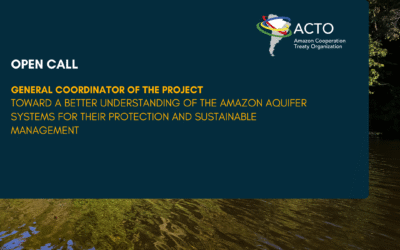August 30, 2016.-The creation of the first Atlas of Hydro-climate Vulnerability of the Amazon Basin is a transcendent scientific fact for the region in which the eight Member Countries of ACTO participated by gathering all the information for the drafting process. This fact is an example of regional cooperation and commitment achieved by the Amazon Cooperation Treaty Organization (ACTO) through the ACTO / UNEP / GEF Project – Water Resources and Climate Change. To produce the Atlas, the International Research Centre on El Niño (CIIFEN) based in Ecuador was selected.
The Atlas synthesizes the complex biophysical and socioeconomic reality of the Amazon basin through 51 thematic maps, making it an essential tool for decision makers. Its development took three years at a cost of $ 300,000.
The Atlas shows the status of infrastructure: electricity, health (distribution of the number of health facilities), mobility and educational facilities of the region as well as the location of protected areas. The map “Digital Elevation Model of the Amazon” was also created.
One of the Atlas´s objectives is to visualize the vulnerability of people and ecosystems to extreme weather events (droughts and floods that cyclically affect the region) by analyzing hydro-climatic threats in the compiled information. For example, Maps of drought threats for the agricultural systems and for the basin´s population and also maps on flood threats for agricultural and community systems were obtained. Similarly, the Maps on the spatial distribution of socioeconomic vulnerability against drought and floods are very innovative, among many other variables investigated.
The Atlas will serve to strengthen the institutions of the region as scientific support for the planning of water resources in the basin considering variability and climate change. A variety of extreme hydro-meteorological and hydro-climatic phenomena are present in climate, affecting the region´s socioeconomic system where on several occasions disasters have occurred. These phenomena can be seen in the maps of average temperature, annual precipitation, and the climate Water Balance, among others.
The Atlas was developed in four phases: In the first phase a bio-geophysical characterization was conducted with more than 10 variables studied such as the basin relief, types of soil, temperature, precipitation, evapotranspiration (transpiration of plants) even climate change, among others, and socioeconomic description of the basin, its population and growth, including economic, agricultural and commercial activities. Standing out are the Maps on Real Evapotranspiration, the Amazon Main Hydrographic Network and the Main Road Networks Distribution in the Region.
On second place, the analysis of hydro-climatic threats was performed. In this context and according to CIIFEN, when a system or part of it is exposed to the impact of a hydro-climate phenomenon is considered a threatening condition, which is valued in terms of probability of loss or damage. The threats by spatial coverage and magnitude of impacts have been the droughts and floods. The analysis of these threats can be seen in detail in the thematic maps.
The third phase of this process which gives new information for the region, was the assessment of vulnerability to extreme hydro-climatic phenomena, by estimating the sensitivity and adaptive capacity of exposed systems (socioeconomic and biophysical), in other words, sensitivity analysis and adaptive capacity was performed for each phenomenon (heavy rains or drought) separately and with two components per hydro-climatic event: biophysicist, that is the environment, vegetation, water networks, floors, etc. and socioeconomic components: population and livelihoods. Processes obtained through the calculation and analysis of vulnerability issues shown in the corresponding maps. An example is the map in which the very low degree of adaptive capacity in the basin for educational infrastructure in large sections of the Amazon is shown.
This led to the final stage where the Hydro-climate Vulnerability Atlas of the Amazon basin was produced, scale 1: 1,000,000. (This means that one centimeter on the map represents one million centimeters on the ground, i.e. 10km).
“Looking ahead, various climate change scenarios suggest that global warming could reach 3 -4 °C by the end of this century and an increased of rainfall, especially in the northwestern sector of the basin ” as stated in the CIIFEN Technical Report, which studied climate change scenarios in the Amazon based on the assembly of four CMPIP5 models (Coupled Model Intercomparison Project Phase 5, for its acronym in English) commonly used by the World Climate Research Programme.
From the information contained in the Atlas, key guidelines were identified to feed the Strategic Actions Plan (SAP) which is the main achievement of the GEF Amazon Project.
From the series of guidelines, the following stand out: “deepen the knowledge ofclimate dynamics ruling the extreme phases of regional climate variability and incorporate the new knowledge into prediction schemes to serve as “early warning alert systems …” and “planning, according with flood-drought cycles”
From the lessons learned in order to move towards reducing the hydroclimatic impacts can only be possible through regional planning, integrated water resources management and disaster risk management.
Source: GEF Amazon Project – ACTO | Photo: Rio Madeira (RuiFaquini/ANA)











